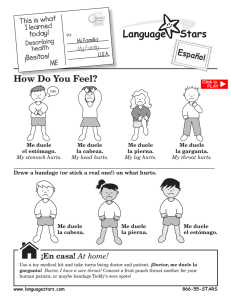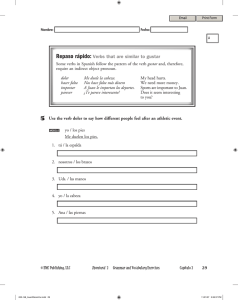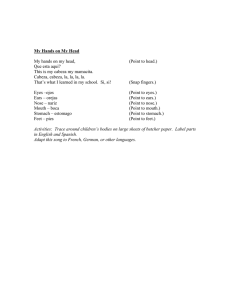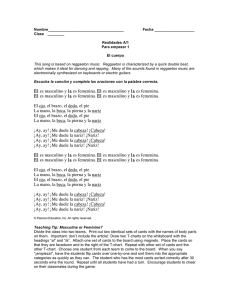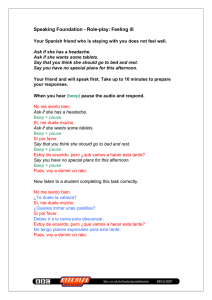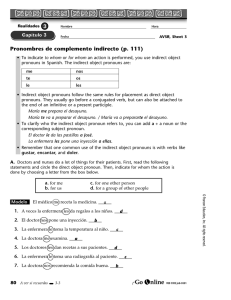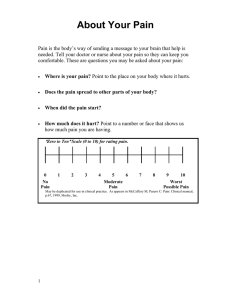Lesson 28 - Guide
Anuncio
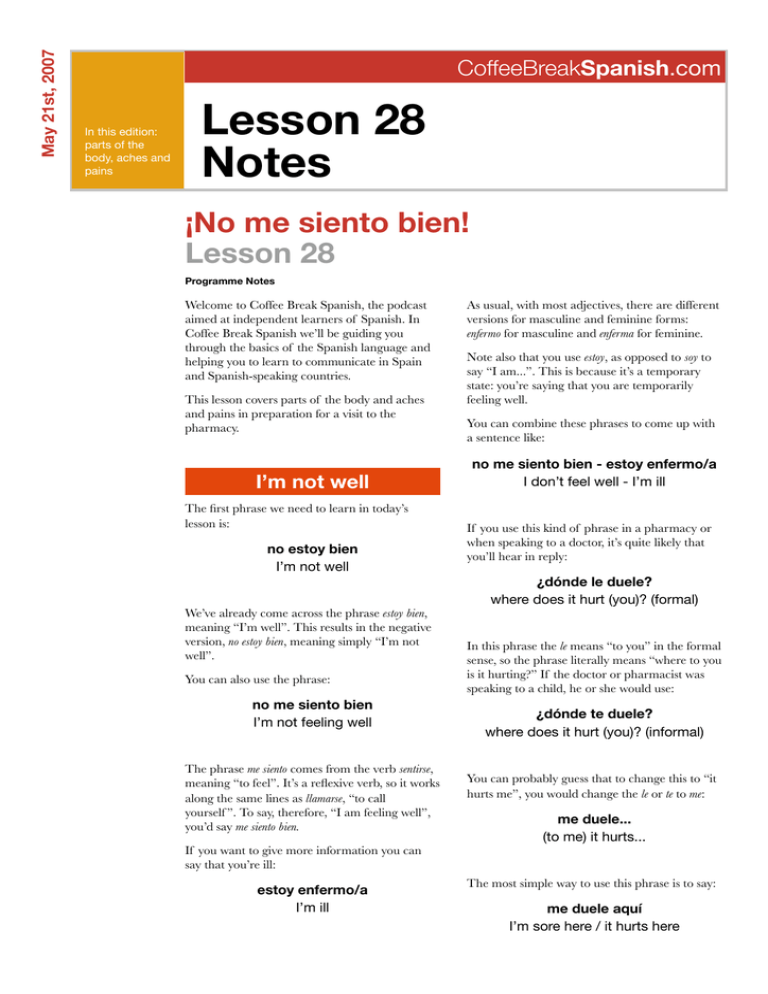
May 21st, 2007 CoffeeBreakSpanish.com In this edition: parts of the body, aches and pains Lesson 28 Notes ¡No me siento bien! Lesson 28 Programme Notes Welcome to Coffee Break Spanish, the podcast aimed at independent learners of Spanish. In Coffee Break Spanish we’ll be guiding you through the basics of the Spanish language and helping you to learn to communicate in Spain and Spanish-speaking countries. This lesson covers parts of the body and aches and pains in preparation for a visit to the pharmacy. As usual, with most adjectives, there are different versions for masculine and feminine forms: enfermo for masculine and enferma for feminine. Note also that you use estoy, as opposed to soy to say “I am...”. This is because it’s a temporary state: you’re saying that you are temporarily feeling well. You can combine these phrases to come up with a sentence like: no me siento bien - estoy enfermo/a I don’t feel well - I’m ill I’m not well The first phrase we need to learn in today’s lesson is: no estoy bien I’m not well We’ve already come across the phrase estoy bien, meaning “I’m well”. This results in the negative version, no estoy bien, meaning simply “I’m not well”. You can also use the phrase: no me siento bien I’m not feeling well If you use this kind of phrase in a pharmacy or when speaking to a doctor, it’s quite likely that you’ll hear in reply: ¿dónde le duele? where does it hurt (you)? (formal) In this phrase the le means “to you” in the formal sense, so the phrase literally means “where to you is it hurting?” If the doctor or pharmacist was speaking to a child, he or she would use: ¿dónde te duele? where does it hurt (you)? (informal) The phrase me siento comes from the verb sentirse, meaning “to feel”. It’s a reflexive verb, so it works along the same lines as llamarse, “to call yourself ”. To say, therefore, “I am feeling well”, you’d say me siento bien. If you want to give more information you can say that you’re ill: You can probably guess that to change this to “it hurts me”, you would change the le or te to me: me duele... (to me) it hurts... The most simple way to use this phrase is to say: estoy enfermo/a I’m ill me duele aquí I’m sore here / it hurts here 1 The phrase me duele is used very commonly with parts of the body to convey pain in a particular area. We’ll now cover some parts of the body, all words which can be used with the above phrase. El cuerpo Until now we’ve been looking at singular nouns: la cabeza, el estómago, la garganta, la pierna, etc. However when you’re talking about something a ‘plural’ part of your body you have to change the verb duele to a plural form: me duelen las piernas my legs hurt / my legs are sore Have a look at the list of vocabulary below: la cabeza head el estómago stomach la garganta throat la pierna leg el brazo arm You can combine any of these items of vocabulary with the phrase me duele... Look at the following examples: me duele la cabeza my head hurts / I have a sore head Depending on where you are in the Englishspeaking world there are various ways to say “I have a headache”. The same applies in Spanish. However, we’re going to concentrate on one way for the time being, using the phrase me duele... Note that me duele la cabeza literally means “to me hurts the head”. The same goes for the following phrases: me duele la garganta my throat hurts / I have a sore throat me duele el brazo my arm hurts / I have a sore arm Many learners of Spanish wonder why it’s not possible to say me duele mi brazo or me duele mi cabeza, using the word for “my”, as opposed to “the”. This is just one of these things that you have to accept. The theory behind it could be linked to the fact that if you were to say me duele la cabeza it’s fairly obvious that it’s your own head that is hurting you as opposed to anyone else’s! Coffee Break Spanish: Lesson 28 As you can see from the table below, the word duele is used for singular parts of the body, and duelen is used for plural parts. It’s also worth pointing out that the same happens in English: the verb changes from “hurts” to “hurt” in the plural! me duele to me hurts... (sing) me duelen to me hurt... (plural) Let’s now look at some additional words for other parts of the body. el ojo eye los ojos eyes la oreja ear las orejas ears la nariz nose la boca mouth el pie foot los pies feet el hombro shoulder los hombros shoulders With any of the above words the plural form uses duelen and the singular duele if you’re talking about things being sore: page 2 me duele la oreja my ear hurts / I have a sore ear Cabeza, hombros, piernas, pies, piernas, pies Ojos, orejas, boca y nariz Cabeza, homrbos, piernas pies, piernas, pies. me duelen las orejas my ears hurt / I have sore ears Una canción This week’s episode finished with a song. Cabeza, hombros, piernas, pies, piernas, pies. Since the majority of this week’s vocabulary has already been listed in the tables in this week’s lesson, there’s no “basic” vocabulary list this week. See below for some additional parts of the body and more useful vocabulary for describing your aches and pains. Note that next week we’ll be covering more vocabulary for talking about health. CoffeeBreakSpanish: Lesson 28 - Bonus Vocabulary la espalda back el tobillo ankle el dedo finger la rodilla knee el codo elbow el cuello neck la muñeca wrist no puedo mover ... I can’t move ... Note that with the phrase no puedo mover ... you use the definite article, eg. no puedo mover la rodilla, means “I can’t move my knee”, but it literally would be translated as “I can’t move the knee”. CoffeeBreakSpanish.com All materials ©Copyright Radio Lingua International 2007 Coffee Break Spanish: Lesson 28 page 3
